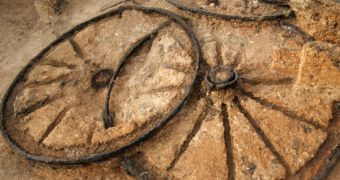A team of Bulgarian archaeologists has recently discovered an entire wooden chariot, sheathed with bronze platings, inside an old Thracian tomb. The ancient vehicle is thought to be about 1,800-year-old and it was found in a southeastern region of the country, close to the village of Karanovo. Alongside the chariot, some well-preserved leather and wooden tools were also uncovered, which the experts assume to have been harnesses for the horses whose bony remains were found close by.
The chariot's bronze plates bear lavish decorations inspired by Thracian mythology, such as a panther depicted while jumping, or the figure of a mythological being with a panther's body and a dolphin-like tail, according to the chief of the excavation, Veselin Ignatov. The 1.2-meter (4-foot) wide vehicle itself was discovered while the specialists were performing digging activities on the site of a burial mound, where a rich aristocrat is believed to have been interred along with his possessions.
This is not the first discovery of this kind, though, as another such complete chariot was found three months ago in the area, within a tomb. According to a senior archaeologist from the Bulgarian Academy of Sciences, Daniela Agre, that was the first intact chariot to be unearthed in Bulgaria, since the previous discoveries only included chariot parts.
This is mainly because the tombs had been looted in 90% of the cases by smugglers long before archaeologists discovered them, and the findings are carried and sold abroad for good money. More than often, the experts lack the necessary funds for discovery, excavation works and security, and complain that looters are better equipped.
Thracians were nomadic Indo-European people, settling in the Balkanic area about five millennia ago and became a powerful empire during the 5th century BC. The people of savvied goldsmiths, savage warriors and skilled horse breeders was conquered by the Romans in the 1st century AD, then by the Slavs four centuries later. There is still much of their wealth to be discovered under the thousands of mounds and at the site of their ancient capital, Seutopolis, at the current “Bulgarian Valley of Kings”.

 14 DAY TRIAL //
14 DAY TRIAL //